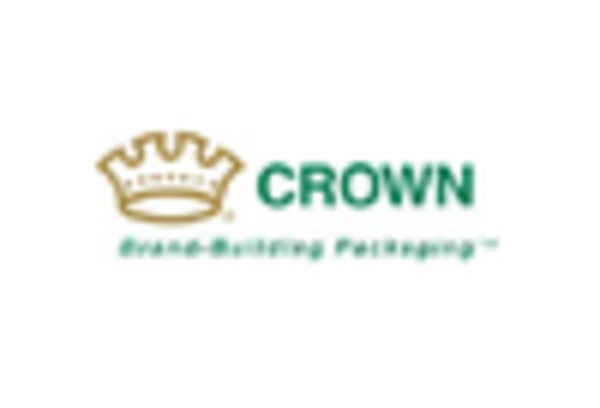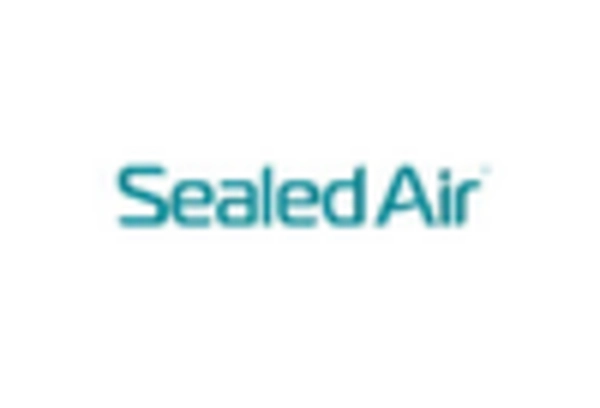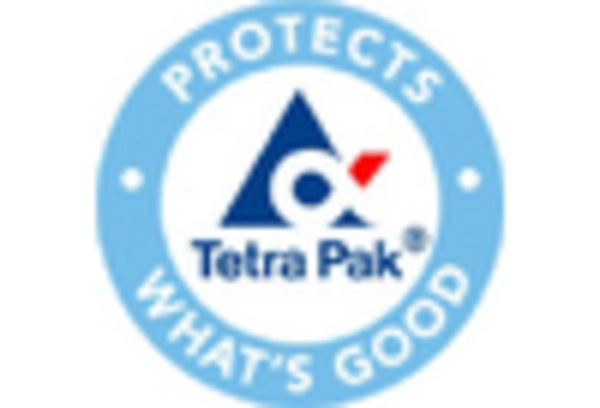Rising Health Consciousness
The increasing awareness of health and hygiene among consumers appears to be a pivotal driver for the Sanitary Food Beverage Packaging Market. As individuals become more discerning about the products they consume, the demand for packaging that ensures safety and cleanliness intensifies. This trend is reflected in market data, indicating that the sanitary packaging segment is projected to grow at a compound annual growth rate of approximately 5.5% over the next five years. Consumers are gravitating towards products that not only promise quality but also come in packaging that minimizes contamination risks. Consequently, manufacturers are compelled to innovate and adopt advanced packaging solutions that align with these health-conscious preferences, thereby enhancing their market positioning.
Technological Advancements in Packaging
Technological innovations are reshaping the landscape of the Sanitary Food Beverage Packaging Market. The integration of smart packaging technologies, such as active and intelligent packaging, is gaining traction. These advancements not only enhance the shelf life of products but also provide real-time information regarding freshness and safety. Market analysis suggests that the adoption of such technologies could lead to a 7% increase in market share for companies that prioritize innovation. As consumers demand more transparency and assurance regarding product safety, manufacturers are increasingly investing in research and development to create packaging solutions that meet these expectations. This technological evolution is likely to redefine industry standards and consumer experiences.
Sustainability and Eco-Friendly Packaging
The growing emphasis on sustainability is significantly influencing the Sanitary Food Beverage Packaging Market. Consumers are increasingly favoring products that utilize eco-friendly packaging materials, prompting manufacturers to adopt sustainable practices. Recent studies indicate that approximately 60% of consumers are willing to pay a premium for products packaged in environmentally friendly materials. This shift towards sustainability not only addresses consumer preferences but also aligns with regulatory pressures aimed at reducing plastic waste. As a result, companies are exploring biodegradable and recyclable materials, which could potentially enhance their market competitiveness. The transition to sustainable packaging solutions is expected to drive innovation and reshape consumer purchasing behaviors in the coming years.
Regulatory Compliance and Safety Standards
The Sanitary Food Beverage Packaging Market is heavily influenced by stringent regulatory compliance and safety standards. Governments and health organizations worldwide are implementing rigorous guidelines to ensure food safety and hygiene. Compliance with these regulations is not merely a legal obligation but also a market differentiator. Companies that adhere to these standards are likely to gain consumer trust and loyalty. Market data suggests that firms investing in compliance-related technologies and practices may experience a 10% increase in customer retention rates. As regulations evolve, manufacturers must remain agile and proactive in adapting their packaging solutions to meet these requirements, thereby enhancing their market presence.
E-commerce Growth and Demand for Convenience
The rapid expansion of e-commerce is reshaping consumer purchasing behaviors, thereby impacting the Sanitary Food Beverage Packaging Market. As more consumers turn to online shopping for food and beverages, the demand for packaging that ensures product integrity during transit is paramount. This trend is evidenced by a projected increase in online food sales, which is expected to grow by 20% annually. Consequently, manufacturers are focusing on developing packaging solutions that not only protect products but also enhance convenience for consumers. This shift towards e-commerce necessitates innovative packaging designs that cater to the unique challenges of online distribution, thereby driving growth in the sanitary packaging sector.


















Leave a Comment